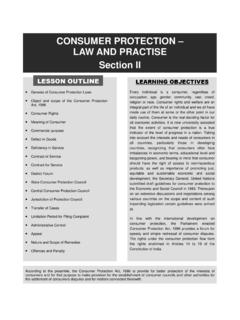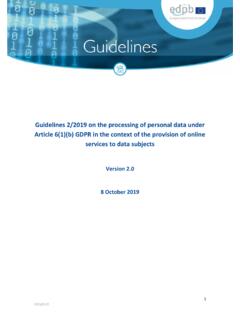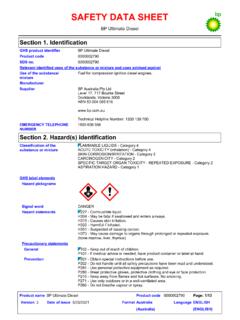Transcription of ARTICLE 29 DATA PROTECTION WORKING PARTY
1 ARTICLE 29 DATA PROTECTION WORKING PARTY This WORKING PARTY was set up under ARTICLE 29 of Directive 95/46/EC. It is an independent European advisory body on data PROTECTION and privacy. Its tasks are described in ARTICLE 30 of Directive 95/46/EC and ARTICLE 15 of Directive 2002/58/EC. The secretariat is provided by Directorate C (Civil Justice, Rights and Citizenship) of the European Commission, Directorate General Justice, Freedom and Security, B-1049 Brussels, Belgium, Office No LX-46 01/43. Website: 01248/07/EN WP 136 Opinion 4/2007 on the concept of personal data Adopted on 20th June -2- THE WORKING PARTY ON THE PROTECTION OF INDIVIDUALS WITH REGARD TO THE PROCESSING OF PERSONAL DATA set up by Directive 95/46/EC of the European Parliament and of the Council of 24 October 19951, having regard to Articles 29 and 30 paragraphs 1 (a) and 3 of that Directive, and ARTICLE 15 paragraph 3 of Directive 2002/58/EC of the European Parliament and of the Council of 12 July 2002 having regard to ARTICLE 255 of the EC Treaty and to Regulation (EC)
2 No 1049/2001 of the European Parliament and of the Council of 30 May 2001 regarding public access to European Parliament, Council and Commission documents having regard to its Rules of Procedure HAS ADOPTED THE PRESENT OPINION: 1 Official Journal No. L 281 of , p. 31, available at: -3- I. GENERAL CONSIDERATIONS AND POLICY ANALYSIS OF THE DEFINITION OF PERSONAL DATA ACCORDING TO THE DATA PROTECTION FIRST ELEMENT: ANY INFORMATION ..62. SECOND ELEMENT: RELATING TO ..93. THIRD ELEMENT: IDENTIFIED OR IDENTIFIABLE [NATURAL PERSON] ..124. FOURTH ELEMENT: NATURAL PERSON ..21IV. WHAT HAPPENS IF THE DATA FALL OUTSIDE OF THE DEFINITION?
3 24V. I. INTRODUCTION The WORKING PARTY is aware of the need to conduct a deep analysis of the concept of personal data. Information about current practice in EU Member States suggests that there is some uncertainty and some diversity in practice among Member States as to important aspects of this concept which may affect the proper functioning of the existing data PROTECTION framework in different contexts. The outcome of this analysis of a central element for the application and interpretation of data PROTECTION rules is bound to have a profound impact on a number of important issues, and will be particularly relevant for topics such as Identity Management in the context of e-Government and e-Health, as well as in the RFID context.
4 The objective of the present opinion of the WORKING PARTY is to come to a common understanding of the concept of personal data, the situations in which national data PROTECTION legislation should be applied, and the way it should be applied. WORKING on a common definition of the notion of personal data is tantamount to defining what falls inside or outside the scope of data PROTECTION rules. A corollary of this work is to provide guidance on the way national data PROTECTION rules should be applied to certain categories of situations occurring Europe-wide, thus contributing to the uniform application of such norms, which is a core function of the ARTICLE 29 WORKING PARTY .
5 This document makes use of examples drawn from the national practice of European DPAs to support and illustrate the analysis. Most examples have only been edited for proper use in this context. -4- II. GENERAL CONSIDERATIONS AND POLICY ISSUES The Directive contains a broad notion of personal data The definition of personal data contained in Directive 95/46/EC (henceforth "the data PROTECTION Directive" or "the Directive") reads as follows: Personal data shall mean any information relating to an identified or identifiable natural person ( data subject ); an identifiable person is one who can be identified, directly or indirectly, in particular by reference to an identification number or to one or more factors specific to his physical, physiological, mental, economic, cultural or social identity.
6 It needs to be noted that this definition reflects the intention of the European lawmaker for a wide notion of "personal data", maintained throughout the legislative process. The Commission's original proposal explained that "as in Convention 108, a broad definition is adopted in order to cover all information which may be linked to an individual"2. The Commission's modified proposal noted that "the amended proposal meets Parliament's wish that the definition of "personal data" should be as general as possible, so as to include all information concerning an identifiable individual"3, a wish that also the Council took into account in the common position4.
7 The objective of the rules contained in the Directive is to protect individuals. Articles 1 of Directive 95/46/EC and of Directive 2002/58/EC clearly state the ultimate purpose of the rules contained therein: to protect the fundamental rights and freedoms of natural persons and in particular their right to privacy, with regard to the processing of personal data. This is a very important element to take into account in the interpretation and application of the rules of both instruments. It may play a substantive role in determining how to apply the provisions of the Directive to a number of situations where the rights of individuals are not at risk, and it may caution against any interpretation of the same rules that would leave individuals deprived of PROTECTION of their rights.
8 The scope of application of the Directive excludes a number of activities, and flexibility is embedded in the text to provide an appropriate legal response to the circumstances at stake Despite the broad concept of personal data' and of 'processing contained in the Directive, the mere fact that a certain situation may be considered as involving 'the processing of personal data' in the sense of the definition does not alone determine that this situation is to be subject to the rules of the Directive, in particular pursuant to ARTICLE 3 thereof. Apart from exemptions due to the remit of community law, the exemptions under ARTICLE 3 take into account the technical way of processing (in manual non-structured form) and the intention of use (for purely personal or household activities by a natural person).
9 Even where processing of personal data within the scope of the Directive is involved, not all the rules contained therein may be applicable in the particular case. A number of provisions of the Directive contain a substantial degree of 2 COM (90) 314 final, , p. 19 (commentary on ARTICLE 2) 3 COM (92) 422 final, , p. 10 (commentary on ARTICLE 2) 4 Common position (EC) No 1/95, adopted by the Council on 20 February 1995, OJ NO C 93 of , -5- flexibility, so as to strike the appropriate balance between PROTECTION of the data subject s rights on the one side, and on the other side the legitimate interests of data controllers, third parties and the public interest which may be present.
10 Some examples of such provisions are contained in ARTICLE 6 (retention period depending on data being necessary), (balance of interest to justify processing), last paragraph of 10 (c) and (c) (information to the data subject where necessary to guarantee fair processing), or 18 (exemptions from notification requirements), just to mention a few cases. The scope of the data PROTECTION rules should not be overstretched An undesirable result would be that of ending up applying data PROTECTION rules to situations which were not intended to be covered by those rules and for which they were not designed by the legislator.

















